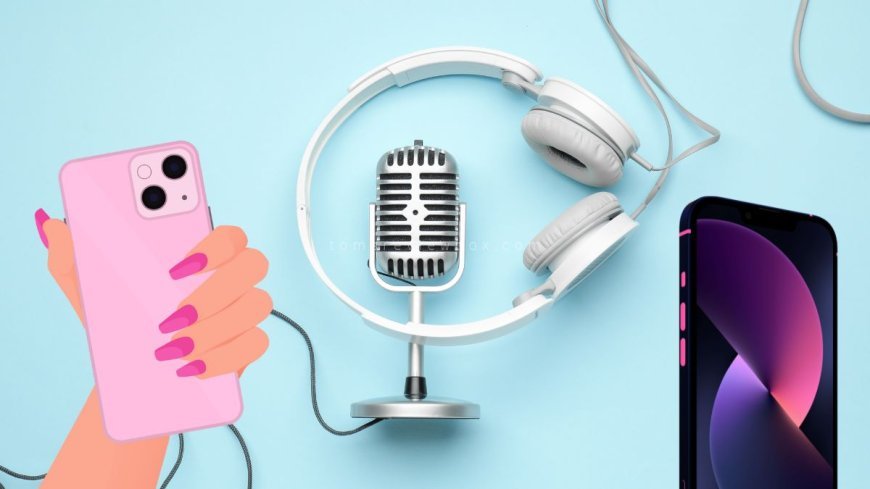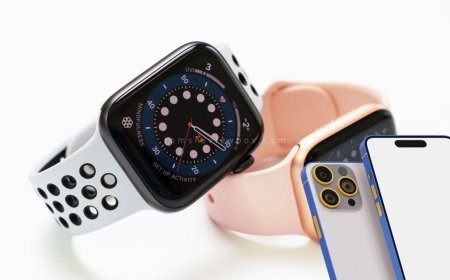How to Make an Audio Recording on iPhone: Expert Tips
Learn expert techniques for audio recording on iPhone in our comprehensive guide. From setup to editing, become a pro in no time!

Looking to capture high-quality audio effortlessly? Say goodbye to bulky recording devices and hello to your pocket-sized powerhouse – the iPhone. With just a few taps, using an external microphone, you can unleash the potential of your device and start creating professional-grade recordings on the go. Whether you're a podcaster, musician, or simply want to document life's moments in crystal-clear sound, your iPhone, with its quality recording and recording tool capabilities, has got you covered.
Ready to dive into the world of mobile recording? In this guide, we'll demystify the process of making audio recordings on your iPhone using microphones to achieve quality sound. From choosing the right app to optimizing settings for top-notch results, we'll walk you through each step. Get ready to elevate your audio game and unlock the full potential of your iPhone as a versatile recording tool.
Key Takeaways
- Start Recording: Utilize the Voice Memos app on your iPhone to begin recording audio effortlessly.
- Organize Recordings: Manage your audio files by categorizing them into folders within the Voice Memos app.
- Share with Ease: Easily share your recordings via messaging, email, or cloud storage directly from the Voice Memos app.
- Enhance Your Recordings: Explore advanced recording tips like using external microphones for better audio quality.
- Practice Privacy: Remember to review and understand the privacy settings when sharing audio files from your iPhone.
- Backup Your Files: Consider backing up your important recordings to prevent accidental loss of data.
Understanding iPhone Audio Capabilities
Can iPhones Record Audio
iPhones possess advanced audio recording capabilities that allow users to create high-quality recordings effortlessly. The built-in Voice Memos app serves as a convenient tool for capturing audio by tapping record on your phone to capture sound. Various iPhone models, from the latest versions to older ones, support audio recording functionalities. For example, the iPhone 12 and iPhone SE both offer exceptional audio recording capabilities.
- Pros:
- Convenient and user-friendly interface
- High-quality recordings without the need for additional equipment
- Cons:
- Limited customization options compared to third-party apps
- Storage space constraints may limit long recordings
High-Quality Recording Tips
To achieve professional-grade audio recordings on your iPhone, consider implementing these effective tips. Begin by ensuring you are in a quiet environment to minimize background noise interference. Adjusting microphone sensitivity settings can help capture clear and crisp sound. Utilizing external microphones or accessories can significantly enhance the quality of your recordings.
- Optimize Settings:
- Adjust microphone sensitivity levels for optimal recording quality.
- Experiment with different settings in the Voice Memos app to find the best configuration.
- Enhance Clarity:
- Positioning the microphone closer to the sound source can improve clarity.
- Use headphones to monitor recordings in real-time and make necessary adjustments.
Getting Started with Voice Memos
To launch the Voice Memos app on your iPhone, simply locate the memo app icon on your home screen. Once found, tap on it to open the application. Upon opening, you will be greeted by a simple and user-friendly interface designed for easy navigation.
When you access the Voice Memos app, you can immediately begin recording audio with just a few taps. The interface offers clear options for starting, pausing, and stopping recordings. You can easily name and manage your recordings within the app for convenient access later.
Making Your Recording
Starting the Recording
To begin an audio recording on your iPhone using Voice Memos, simply tap on the red record button. This action initiates a new recording session where you can capture your voice or any other audio. For instance, if you want to record a lecture, press the red button to start the step.
When starting a recording on your device, locate and press the red record button within the Voice Memos app. This action prompts the app to begin capturing audio input through your iPhone's microphone. Once you press the red button, the recording process commences immediately.
Initiating a new recording session is straightforward on your iPhone. By tapping on the red record button, you signal to the device that you are ready to start capturing audio. Whether it's a personal reminder or an important interview, this simple step kickstarts your recording process efficiently.
During the Recording
While actively recording audio on your iPhone, ensure a quiet environment for optimal sound quality. Monitor your voice levels during the session to avoid distortion in the recording. Make sure to speak clearly and at an appropriate volume for better results.
To guarantee a smooth recording experience, maintain a steady hand while holding your device. Adjusting recording settings such as microphone sensitivity can help enhance audio clarity. By being attentive to these details during the session, you can produce high-quality recordings effortlessly.
Throughout the recording process, keep an eye on important features like pause and stop buttons for necessary actions. These buttons allow you to pause momentarily or stop completely when needed. Monitoring and adjusting these functions as required ensures precise control over your recordings.
Pausing or Stopping
When it comes to pausing or stopping an ongoing recording, utilize the dedicated buttons within the Voice Memos app. Pressing pause allows you to temporarily halt the recording without ending it entirely. On the other hand, hitting stop signifies that you have completed capturing audio for that particular session.
Effectively using the pause and stop buttons during recording sessions enables seamless transitions between segments of audio content. Pausing at specific points helps in maintaining organization and clarity in your recordings. Likewise, stopping accurately marks completion of each segment for later reference.
Understanding when to pause or stop recordings at strategic intervals is crucial for creating coherent audio content. By utilizing these options effectively, you can ensure that each section of your recorded material flows smoothly and remains distinct from others.
Managing Your Recordings
Naming and Saving
When you record audio on your iPhone using the Voice Memos app, it's crucial to name and save your recordings for easy access later. By customizing names, you can quickly identify and locate specific recordings within the app. Saving recordings ensures that they are not lost and can be accessed whenever needed.
- To name a recording, simply tap on the three dots next to the file and select "Rename." Enter a descriptive name that helps you recognize the content of the recording.
- Saving a recording is as simple as tapping on "Save" after finishing your recording. This action stores the audio file securely within the Voice Memos app.
- Properly naming and saving your recordings enhances organization and efficiency when managing multiple audio files on your iPhone.
Accessing and Editing
After creating audio recordings on your iPhone, it's essential to know how to access and edit them using the Voice Memos app. Accessing recorded files allows you to listen to or share them with others easily. Editing capabilities enable you to enhance the quality of your recordings for better playback.
- To access your recorded files, open the Voice Memos app and navigate to the list of recordings. Tap on a specific file to play or share it.
- When it comes to editing, Voice Memos offers options such as trimming excess parts of the recording, adjusting playback speed, and enhancing sound quality.
- Trimming allows you to remove unwanted sections from your recording, ensuring only relevant content is retained. Adjusting playback speed can help in transcribing or listening at different speeds.
Sharing Your Audio Files
Sharing Techniques
Understanding the various methods available for sharing audio recordings from your iPhone is essential. You can easily share your recorded audio content with friends, family, or colleagues using different options. For instance, you can utilize AirDrop, Messages, and Mail to send your recordings quickly and conveniently.
Exploring sharing options such as AirDrop allows you to transfer your audio files wirelessly to nearby Apple devices. This method is ideal for instant sharing without the need for additional apps or services. Using Messages enables you to send your recordings directly through text messages to individuals or groups.
Learning how to share recordings with devices beyond the iOS ecosystem opens up more possibilities for collaboration and communication. By utilizing email services like Mail, you can share your audio notes with contacts who use non-Apple devices seamlessly. This ensures that regardless of the recipient's device preference, they can still access and enjoy your audio content.
Advanced Recording Tips
Enhancing Audio Quality
To enhance the audio quality of your recordings, focus on techniques that improve sound clarity and remove background noise effectively. Utilize tools available within Voice Memos to elevate the overall audio experience.
One way to improve sound clarity is by recording in a quiet environment to minimize external disturbances. Consider using a high-quality microphone for better audio capture.
Removing background noise can significantly enhance the listening experience. To achieve this, try using noise reduction features available in various recording apps or software.
Explore the tools within Voice Memos such as equalizers and filters to adjust the audio settings according to your preferences. These features can help you fine-tune your recordings for optimal sound quality.
FAQs on iPhone Recording
Secret Recording Queries
Secret audio recordings have serious implications, raising legal and ethical concerns. Understanding the consequences of recording conversations without consent is crucial. It's essential to explore the legality surrounding secret recordings to avoid potential legal issues.
Consider the ethical aspects of secretly recording audio on your iPhone. Exploring the boundaries between privacy invasion and lawful recording practices is important. Being aware of the ethical implications can help you make informed decisions regarding secret recordings.
Recording audio without consent can lead to severe consequences, including legal repercussions. Learning about the potential penalties for unauthorized recordings is vital. Understanding the risks involved in secret audio recordings can prevent unwanted legal troubles.
Recording Audio Only
To record audio only on your iPhone, focus on capturing sound without video. Learning how to utilize this feature can be beneficial for various purposes such as interviews or voice memos. The simplicity of capturing audio-only content makes it a convenient option for many users.
Capturing audio without video offers several benefits, including smaller file sizes and reduced storage requirements. Exploring the advantages of recording solely audio content can help you optimize your iPhone's capabilities efficiently. Audio-only recordings are ideal for situations where visuals are unnecessary.
Recording audio without video on your iPhone is straightforward and convenient. Understanding how to use this feature effectively can enhance your recording experience. The simplicity of focusing solely on audio ensures a seamless recording process.
Using iPhone as Recorder
Your iPhone serves as a versatile tool for various tasks, including high-quality audio recording. Discovering the diverse applications of using your device as a dedicated recorder opens up new possibilities for creativity and productivity. Leveraging your iPhone's recording capabilities enhances its functionality beyond communication.
Utilizing your iPhone as a recorder offers numerous advantages, such as portability and ease of use. Learning how to maximize its recording features allows you to capture clear and crisp audio in any situation. The convenience of having a reliable recording device at your fingertips simplifies many tasks.
Explore innovative ways to optimize your iPhone's recording capabilities for different scenarios, from interviews to music production. Discovering creative methods to enhance your recordings elevates the quality of your audio content significantly. Experimenting with different settings and techniques unlocks the full potential of using your iPhone as a recorder.
Final Remarks
You've now mastered the art of recording audio on your iPhone. Understanding its capabilities, using Voice Memos efficiently, managing and sharing your recordings, and applying advanced tips are all at your fingertips. With these skills, you can capture moments, create content, or simply save important information with ease.
Don't hesitate to explore further and experiment with different recording techniques. Your iPhone is a powerful tool waiting for you to unleash its full potential. Start recording, sharing your voice, and making the most of every audio opportunity that comes your way.
Frequently Asked Questions
How can I access Voice Memos on my iPhone?
To access Voice Memos on your iPhone, simply locate the app icon on your home screen. It typically appears as a white icon with an image of sound waves. Tap on the icon to open the app and start recording audio.
Can I edit my recordings in Voice Memos?
Yes, you can edit your recordings in Voice Memos. After selecting a recording, tap the three dots (...) and choose "Edit Recording." From there, you can trim the audio, adjust the volume, or add more to the recording.
What formats are supported for sharing audio files from iPhone?
When sharing audio files from your iPhone, common formats like MP3 and M4A are widely supported. These formats ensure compatibility with various devices and platforms, making it easy to share your recordings with others seamlessly.
Is it possible to transfer audio recordings from iPhone to a computer?
Yes, you can transfer audio recordings from your iPhone to a computer using methods such as iCloud Drive, AirDrop, or connecting your device via USB. This allows you to backup or further work on your recordings using desktop software.
Can I set reminders for recording tasks using Voice Memos?
While Voice Memos itself does not have a built-in reminder feature, you can utilize external apps or tools like the iPhone's native Reminders app to schedule recording tasks. Simply set a reminder for when you need to make a recording and launch Voice Memos at that time.
What's Your Reaction?







































![MacBook Pro M5: All the features and specs you need to know [LEAKS REVEALED]](https://tomsreviewbox.com/uploads/images/202502/image_430x256_67bd6d7cd7562.jpg)



























